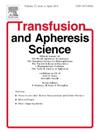CAPRIN2 RNA-binding protein contributes to balance erythroid production: Implications in the fine-tuning of proteostasis during erythropoiesis
IF 1.4
4区 医学
Q4 HEMATOLOGY
引用次数: 0
Abstract
Erythropoiesis is a process that requires tight control of gene transcription, mRNA stability, and protein synthesis and degradation. These regulatory layers adapt dynamically to developmental needs and physiological stresses, ensuring precise control of erythroid production. Ribosomopathies, such as Diamond-Blackfan anemia (DBA), are characterized by defects in ribosome function. Zooming in on erythroid precursors, ribosomopathies lead to dysregulated translation of mRNAs encoding specific and essential erythropoietic genes, including master transcription factors such as GATA1. This causes defective maturation and increased apoptosis of erythroid progenitors, and consequently, anemia. Beyond ribosomal proteins, RNA-binding proteins have been put forward as an additional and targeted checkpoint regulating cellular proteostasis. CAPRIN2, which is present in neurons and erythroid cells, is one such RNA-binding protein, involved in RNA translation regulation and its levels rise during terminal erythroid differentiation. Overexpression of CAPRIN2 in Chinese hamster ovary (CHO) cells causes reduced growth, cell cycle arrest, and apoptosis. Here, we demonstrate that GATA1 potentially regulates Caprin2 transcription, and that Caprin2 loss boosts erythroid production and maturation during gestation and adulthood, a phenomenon that is enhanced in situations of stress erythropoiesis. Our results provide new insight into the role of CAPRIN2 in erythropoiesis. We hypothesize that it regulates the translation of key mRNAs during erythropoiesis. We propose that CAPRIN2 is involved in the balance of erythroid production and that its manipulation may control erythroid production, offering a potential and promising approach to manage altered erythropoiesis.
求助全文
约1分钟内获得全文
求助全文
来源期刊
CiteScore
3.60
自引率
5.30%
发文量
181
审稿时长
42 days
期刊介绍:
Transfusion and Apheresis Science brings comprehensive and up-to-date information to physicians and health care professionals involved in the rapidly changing fields of transfusion medicine, hemostasis and apheresis. The journal presents original articles relating to scientific and clinical studies in the areas of immunohematology, transfusion practice, bleeding and thrombotic disorders and both therapeutic and donor apheresis including hematopoietic stem cells. Topics covered include the collection and processing of blood, compatibility testing and guidelines for the use of blood products, as well as screening for and transmission of blood-borne diseases. All areas of apheresis - therapeutic and collection - are also addressed. We would like to specifically encourage allied health professionals in this area to submit manuscripts that relate to improved patient and donor care, technical aspects and educational issues.
Transfusion and Apheresis Science features a "Theme" section which includes, in each issue, a group of papers designed to review a specific topic of current importance in transfusion and hemostasis for the discussion of topical issues specific to apheresis and focuses on the operators'' viewpoint. Another section is "What''s Happening" which provides informal reporting of activities in the field. In addition, brief case reports and Letters to the Editor, as well as reviews of meetings and events of general interest, and a listing of recent patents make the journal a complete source of information for practitioners of transfusion, hemostasis and apheresis science. Immediate dissemination of important information is ensured by the commitment of Transfusion and Apheresis Science to rapid publication of both symposia and submitted papers.

 求助内容:
求助内容: 应助结果提醒方式:
应助结果提醒方式:


